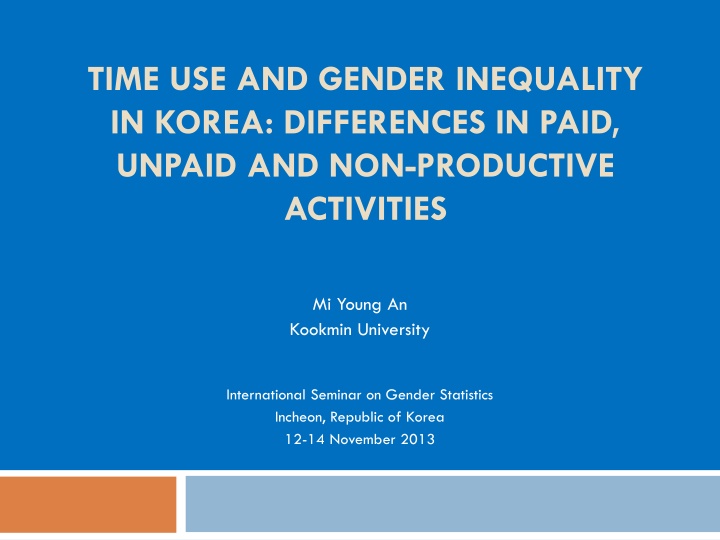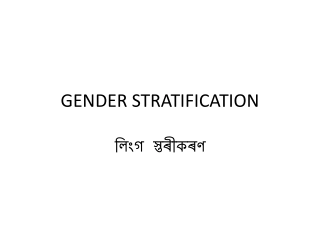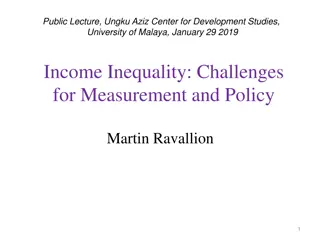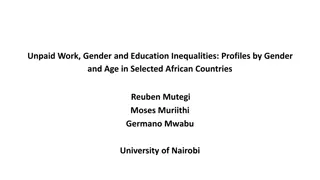Gender Inequality in Korea: Time Use Disparities
This study explores differences in paid, unpaid, and non-productive activities in Korea, shedding light on gender inequalities in time use. It delves into changes in demographic and social-economic factors, as well as shifts in living arrangements over the years. The definitions of paid and unpaid work, informed by the System of National Accounts, are also examined to understand the scope of economic activities considered within the GDP calculation.
Download Presentation

Please find below an Image/Link to download the presentation.
The content on the website is provided AS IS for your information and personal use only. It may not be sold, licensed, or shared on other websites without obtaining consent from the author.If you encounter any issues during the download, it is possible that the publisher has removed the file from their server.
You are allowed to download the files provided on this website for personal or commercial use, subject to the condition that they are used lawfully. All files are the property of their respective owners.
The content on the website is provided AS IS for your information and personal use only. It may not be sold, licensed, or shared on other websites without obtaining consent from the author.
E N D
Presentation Transcript
TIME USE AND GENDER INEQUALITY IN KOREA: DIFFERENCES IN PAID, UNPAID AND NON-PRODUCTIVE ACTIVITIES Mi Young An Kookmin University International Seminar on Gender Statistics Incheon, Republic of Korea 12-14 November 2013
Demographic, social-economic changes 90 12 80 10 70 60 8 50 6 40 30 4 20 2 10 0 0 1970 1971 1972 1973 1974 1975 1976 1977 1978 1979 1980 1981 1982 1983 1984 1985 1986 1987 1988 1989 1990 1991 1992 1993 1994 1995 1996 1997 1998 1999 2000 2001 2002 2003 2004 2005 2006 2007 2008 2009 2010 2011 2012 Female Labour Market Participation Rate (%) (FLMP) Male Labour Market Participation Rate (MLPR) Total Fertility Rate (TFR) Crude Marriage Rate (CMR) Crude Divorce Rate (CDR)
Changes in living arrangements Table 1. Distribution of households by number of generations in Korea (%) One Two Three & four Total generation 1960 7.5 64.3 28.2 100 1970 6.8 70.0 23.2 100 1980 9.0 73.2 17.8 100 1990 12.0 74.1 13.9 100 1995 14.7 73.7 11.6 100 2000 17.1 72.9 10.1 100 2005 20.6 70.5 8.9 100
Continued Table 2. Distribution of households by number of household members in Korea (%) One Two Three/four Five & over Average Household Size 1960 2.3 7.1 26.5 64.1 5.6 1970 3.7 9.4 27.8 59.1 5.2 1980 4.8 10.5 34.8 49.9 4.5 1990 9.0 13.8 48.6 28.6 3.7 1995 12.7 17.3 52.1 17.9 3.3 2000 15.5 19.1 52.0 13.4 3.1 2005 20.0 22.2 47.9 9.9 2.9
Defining paid and unpaid work Definitions for paid and unpaid work informed by the System of National Accounts (SNA). The SNA has established rules that countries must use in calculating Gross Domestic Product (GDP). More specifically, only those activities that fall within the production boundary of the SNA should be included when calculating GDP. This production boundary includes all production of goods and services for the market as well as the production of goods for personal consumption. As such, the boundary includes subsistence production, unpaid work in the family business, and even the collection of fuel and water. The SNA recognizes that the production boundary does not cover all forms of work or production. In particular, the boundary excludes unpaid production of services, which is normally referred to as household maintenance and family care. Paid Work(SNA work): All activities classified under the employment category, including time spent for work-related travel. Unpaid Care Work (extended SNA work): All activities related to household maintenance, family care, and voluntary service (e.g., help for others in the community). In addition, family care and help for others in the community has been combined into personal care . Therefore, extended SNA work includes household maintenance and personal care. Non-productive work: All other activities
Identification of key determinants of time spent on care Table 3. Regression outputs on duration of time spent on unpaid care work, 1999, 2004 Coef. Std.Err t P>t 1999 2004 1999 2004 1999 2004 1999 2004 -228.7 - 203.2 1.2 1.3 -181.4 -146.6 0.000 0.000 Male 85.7 63.6 1.7 1.9 49.4 33.1 0.000 0.000 Married -126.9 - 127.3 1.3 1.5 -93.3 -83.3 0.000 0.000 Employed 93.4 130.3 1.5 2.0 61.6 63.8 0.000 0.000 Childed 0.7 1.7 1.9 2.2 4.1 0.7 0.684 0.444 LowEd 1.6 3.8 1.7 1.7 9.3 2.2 0.351 0.026 HighEd 15.5 16.4 0.2 0.2 796.0 74.0 0.000 0.000 Age -0.1 -1.5 .0 0 -724.4 -64.8 0.000 0.000 Age squared -146.4 - 157.1 3.4 3.8 -422.3 -41.2 0.000 0.000 Constant
Continued Table 4. Regression outputs on duration of time spent on person care, 1999, 2004 Coef. Std.Err t P>t 1999 2004 1999 2004 1999 2004 1999 2004 -106.9 -88.2 1.6 1.8 -64.7 -48.3 0.000 0.000 Male 98.0 79.7 2.3 2.6 41.7 29.8 0.000 0.000 Married -82.5 -90.2 1.6 1.9 -49.5 -46.8 0.000 0.000 Employed 165.2 180.7 1.7 2.3 95.3 77.1 0.000 0.000 Childed -17.9 -9.8 2.4 2.9 -7.3 -3.3 0.000 0.001 LowEd 10.2 9.7 2.0 2.1 4.9 4.6 0.000 0.000 HighEd 8.8 8.9 0.2 0.3 30.6 28.8 0.000 0.000 Age -0.09 -0.1 .0 .0 -30.4 -28.8 0.000 0.000 Age squared -278.7 -256.5 5.0 5.5 -55.2 -46.4 0.000 0.000 Constant
Time spent on paid work and unpaid care work Table 5. Time on Paid and Unpaid Care Work by sex (%), 1999 and 2004 1999 2004 MPT PR MPT PR Male SNA work 22 60 21 60 Household maintenance 1 36 2 37 Person care 1 15 1 17 Female SNA work 13 42 12 42 Household maintenance 11 83 11 82 Person care 3 40 3 39
Continued Table 6. Time on Paid and Unpaid Care Work by Sex and Age Group (%), 1999 and 2004 1999 2004 MPT PR MPT PR SNA work 0.1 0 0.1 0.1 10-14 Household maintenance 0.5 1 5 23 Person care 0.1 0.4 2 8 SNA work 26 68 25 68 Male 15-64 Household maintenance 1 36 1 37 Person care 1 16 1 19 SNA work 12 49 12 49 65+ Household maintenance 3 54 3 59 Person care 1 14 1 15 SNA work 0.1 0.1 0 0 10-14 Household maintenance 1 3 10 35 Person care 0.3 0.8 3 10 SNA work 15 46 14 47 Female 15-64 Household maintenance 12 87 11 85 Person care 3 45 4 44 SNA work 8 37 7 36 65+ Household maintenance 12 90 12 93 Person care 1 21 1 21
Continued Table 7. Time on Paid and Unpaid Care Work by Sex and Education (%), 1999 and 2004 1999 2004 MPT PR MPT PR SNA work 22 68 19 67 Low Household maintenance 2 54 2 54 Person care 1 14 1 14 SNA work 30 79 28 76 Male Middle Household maintenance 1 37 1 41 Person care 1 18 1 20 SNA work 1 36 1 38 High Household maintenance 3 54 3 59 Person care 1 21 1 23 SNA work 15 53 12 48 Low Household maintenance 13 95 13 95 Person care 2 25 1 25 SNA work 15 49 15 49 Female Middle Household maintenance 15 94 14 95 Person care 4 58 4 54 SNA work 17 51 16 50 High Household maintenance 11 85 10 84 Person care 5 52 5 51
Continued Table 8. Time on Paid and Unpaid Care Work by Sex and Marital Status (%), 1999 and 2004 1999 2004 MPT PR MPT PR SNA work 11 30 11 32 Single Household maintenance 1 31 1 30 Person care 0.5 5 1 6 SNA work 29 79 28 78 Male Married Household maintenance 1 38 2 41 Person care 1 21 1 24 SNA work 19 56 17 56 Divorced/ Widowed Household maintenance 4 63 4 71 Person care 1 14 1 14 SNA work 10 28 11 31 Single Household maintenance 2 53 2 48 Person care 0.3 8 0.3 7 SNA work 14 48 13 46 Female Married Household maintenance 16 98 15 98 Person care 4 60 5 59 SNA work 13 45 12 43 Divorced/ Widowed Household maintenance 11 90 11 93 Person care 1 25 1 23
Continued Table 9. Time on Paid and Unpaid Care Work by Sex and Children Status (%), 1999 and 2004 1999 2004 MPT PR MPT PR SNA work 31 80 32 85 With preschool children Household maintenance 1 32 1 36 Person care 2 38 2 51 Male SNA work 20 56 19 56 Without preschool children Household maintenance 1 37 1 38 Person care 1 9 1 11 SNA work 9 34 9 33 With preschool children Household maintenance 14 91 14 98 Person care 10 83 13 98 Female SNA work 14 44 13 43 Without preschool children Household maintenance 11 81 10 80 Person care 1 28 1 29
Continued Table 10. Time on Paid and Unpaid Care Work by Sex and Work Status (%), 1999 and 2004 1999 2004 MPT PR MPT PR SNA work 34 89 32 86 Working Household maintenance 1 36 1 38 Person care 1 17 1 20 Male SNA work 1 7 1 8 Not Household maintenance 2 38 2 38 Working Person care 1 11 1 12 SNA work 28 86 26 83 Working Household maintenance 10 89 9 87 Person care 2 37 2 36 Female SNA work 1 5 1 6 Not Household maintenance 12 62 12 79 Working Person care 4 42 4 42
Continued Table 11. Time on Work and Care by Household Type (%), 1999 and 2004 1999 2004 SNA Work Household maintenance Person care SNA Work Household maintenance Person care Ch+Ad 18 47 1 29 1 10 17 47 1 30 1 13 Ch+Ad+O ld 16 46 1 30 1 12 14 44 1 31 1 15 Ad 29 76 1 39 1 20 27 73 1 40 1 22 Male Ad+Old 23 65 2 42 1 17 22 65 2 42 1 15 Old 14 55 3 61 1 12 13 54 4 64 1 14 Ch+Old 5 20 1 40 1 11 4 16 1 37 1 10 Ch+Ad 11 35 9 73 2 36 10 34 9 70 2 40 Ch+Ad+O ld 11 39 9 76 2 30 9 33 9 72 2 35 Ad 15 46 13 92 5 52 15 48 11 89 5 46 Female Ad+Old 14 48 12 88 3 38 13 46 13 88 3 34 Old 12 49 14 97 2 18 10 46 14 97 1 18 Ch+Old 6 25 9 80 1 30 5 21 10 80 1 27
Valuation and comparison of unpaid care work Table 12. Unpaid Care Work and Person Care as Percentage of GDP: Different Approaches Unpaid care work Person care Male Female Total Male Female Total Average earnings for all employed 6 24 29 2 6 8 Average waged of all employees 5 24 29 2 6 8 Average generalist wage - - 18 - - 5 Average domestic worker wage - - 19 - - 5
Continued Table 13. Total Value of Unpaid Care Work and Person by Year (Thousand Million Won): Different Approaches Unpaid care work Person care Male Female Total Male Female Total Average earnings for all employed 46,530 183,659 225,125 18,684 43,240 59,335 Average waged of all employees 41,297 185,944 222,685 16,583 43,777 58,692 Average generalist wage - - 138,086 - - 36,395 Average domestic worker wage - - 144,861 - - 38,180























